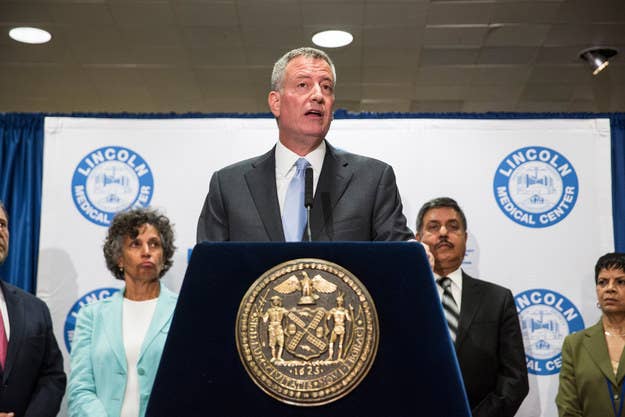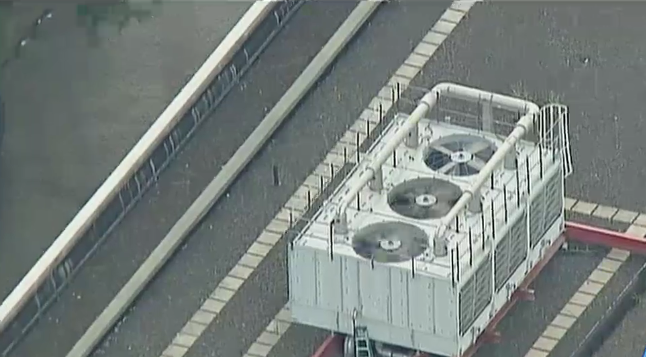Mayor de Blasio said on Monday that two more people have succumbed to the deadly Legionnaires' disease but added that no new cases have been reported since August 3.

While two more deaths have been reported and four more cases have been added to the total of those infected, it's been six days since any new cases have been reported, mayor de Blasio said on Monday. This indicates that the outbreak is getting under control.
The total number of deaths jumped to 12 and the total number of cases is at 113, the mayor said.
Over the weekend, the city identified 161 buildings in the South Bronx that may contain cooling towers and after a complete canvas of the Legionnaires' impact zone, that number was whittled down to 39 buildings confirmed to have cooling towers. Of those, 12 have tested positive for the legionella bacteria and another five samples are still outstanding and expected back by the end of day Monday, the mayor said. De Blasio also added that all of the buildings that have tested positive will be disinfected by the end of the day Monday.
The mayor announced that the city council is working on drafting legislation that will require all buildings to register their cooling towers with the city and have them inspected quarterly. The bill will be discussed in a hearing Tuesday and is expected to be passed on Thursday, city council speak Melissa Mark-Viverito said.
Details of that legislation are still being ironed out but the speaker did say that buildings would also be required to pass an annual certification and that all buildings will have 60 days from the passage of the bill in order to register existing cooling towers.
The New York City health commissioner, Dr. Mary T. Bassett, ordered all owners of buildings with cooling towers Saturday to disinfect those towers within two weeks in response to a deadly outbreak of Legionnaires' disease.

State health officials convened for a press conference at the Manhattan office of Gov. Andrew Cuomo on Friday to discuss the largest outbreak of Legionnaires' disease in New York City history.
The outbreak was discovered by the city in late July and was narrowed down to five water-cooling towers in the South Bronx, though they are still unsure which is responsible for the outbreak, the New York Times reported.
So far 101 people have been infected with the legionella bacterium, 10 of whom have died. The surviving patients have been treated or remain in Lincoln Medical Center in the Bronx.
The day before the press conference, city health officials issued a public order requiring all buildings with cooling towers to disinfect their water within 14 days, and to maintain records of their inspection.
It is unknown exactly how many cooling towers there are in New York City, but Bassett said Thursday that there are at least 2,500, mostly in industrial or commercial areas.
Beginning Saturday, the state will deploy teams to expedite the process of inspecting and testing the towers. The teams will aid in the citywide disinfection process and work to isolate which tower in the Bronx contains the bacteria.
Bassett announced on Friday that there have been no new fatalities from the disease, and only one new case announced since the seven they diagnosed earlier in the week.
Our goal for every cooling tower in the outbreak area is to find it, treat it and clean it.
"While it is clearly a significant outbreak in the Bronx, this is a statewide issue and the governor is monitoring Legionnaires' statewide," the New York State health commissioner, Dr. Howard A. Zucker, said at the conference.
"The outbreak has not affected the city's drinking or bathing water," the New York Department of Health announced on its website. "It is safe for building residents to drink and bathe with tap water."
Dr. Claressa Lucas — who is leading the investigative team for the Center for Disease Control and Prevention, and with whom the city says they have kept in close contact while investigating the disease — said she thought the city had done a "very good job in mobilizing their resources and reaching out to their partners for overflow."
"Our interventions have been effective, and we've contained this outbreak," Bassett said on Twitter Saturday. Yet, she admitted, their job is not yet done.
Our job isn’t done. @nychealthy remains vigilant. Our disease detectives are still working around the clock.
The respiratory disease, which causes pneumonia-like symptoms, isn't transmitted from person to person but through contact with Legionella bacteria, which thrive in warm water.
The bacteria can become particularly dangerous when the water forms a mist that can be inhaled, as it can in open fire hydrants, air conditioning systems, public fountains, or showers.

Legionella is a bacteria and not a virus, as one paragraph of this article previously stated.

